



















|
 |
|
 |

This page shows troops you will fight against or hire in the Balkans area, which means Getia, Illyria, Thrace & Greece itself.
Komatai (Dacian Skirmishers)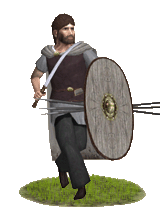 The Komatai, also called ‘daoi’ or ’wolves,’ make up the bulk of the tribal forces of the Getai. Untamed warriors, they are still capable of versatile maneuvers on the battlefield. They fight bare-headed to assure the gods of their fervor and willingness to arrive at their side. The Komatai go to battle wearing studded leather armor, baggy trousers and a large oval shield. They also carry with them javelins and a sica. They are best used as skirmishers for hit-and-run tactics and can be deadly in forests. If forced into melee they can hold their own against other light and even some medium infantry. The Komatai, also called ‘daoi’ or ’wolves,’ make up the bulk of the tribal forces of the Getai. Untamed warriors, they are still capable of versatile maneuvers on the battlefield. They fight bare-headed to assure the gods of their fervor and willingness to arrive at their side. The Komatai go to battle wearing studded leather armor, baggy trousers and a large oval shield. They also carry with them javelins and a sica. They are best used as skirmishers for hit-and-run tactics and can be deadly in forests. If forced into melee they can hold their own against other light and even some medium infantry.
Historically, the Komatai were the perfect example of the transitional process of the tribal communities to a stately structure. They were free men, still gathering at the tribe’s calling, but the tribe’s calling was increasingly a response to a call from a tribal union or from the Basileus himself. By the middle of the third century BC large unions of tribes had begun to fight for the hegemony in the area from the Karpathes to the Istros. The Komatai made up the vast majority of warriors, while the disparities between the komatai and the noble tarabostes grew to an even greater extent. The Getic warriors were renowned for their zeal in battle—it was rumored that they did not fear death because of their belief in the immortality of their souls.
Komatai Sphendonitai (Dacian Slingers)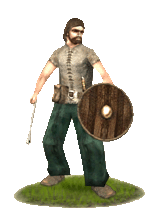 These skirmishers are a valuable addition to any Getic army and can perform superbly in rough terrain. They carry no armor to speak of, except small round shields, and are armed with slings and an akinakes dagger. They are usually very young men and their role is merely to try and force the enemy into acting rashly, even though unarmored troops could pay much more dearly if facing them. Any wise leader should try to keep them away from prolonged melees, even though they will fight back with more vigor than troops of this type are expected. These skirmishers are a valuable addition to any Getic army and can perform superbly in rough terrain. They carry no armor to speak of, except small round shields, and are armed with slings and an akinakes dagger. They are usually very young men and their role is merely to try and force the enemy into acting rashly, even though unarmored troops could pay much more dearly if facing them. Any wise leader should try to keep them away from prolonged melees, even though they will fight back with more vigor than troops of this type are expected.
Historically, these slingers had no distinct ability from their counterparts, though they acted more independently on the battlefield and were probably more accustomed to flank attacks than form a loose fore-front as the Greek psiloi. Their numbers were never great, thanks to the popularity of the bow among the Getai. Their akinakes and small shields offered them enough protection not to fear acting as support troops.
Drapanai (Dacian Falxmen)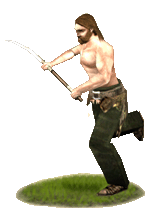 The Drapanai contingents are made up of resolute warriors, well aware of their role on the battlefield as shock troops. While the average Getic soldier tells himself he is immortal, the Drapanai, more than any others, join battle without fear of death. They fight bare-chested and with only baggy trousers, not for protection but to keep some warmth. Their trademark though is the falx, a vicious blade capable of severing limbs and causing horrible wounds with a single, crushing blow. These warriors are best used as shock troops against enemy infantry. If used properly, they can cut their way through and open a gap in the enemy battle line, allowing other Getic warriors to exploit the opening. Their lack of armor might be a drawback against concentrated enemy missile fire and they should thus not be exposed to enemy ranged infantry needlessly. The Drapanai contingents are made up of resolute warriors, well aware of their role on the battlefield as shock troops. While the average Getic soldier tells himself he is immortal, the Drapanai, more than any others, join battle without fear of death. They fight bare-chested and with only baggy trousers, not for protection but to keep some warmth. Their trademark though is the falx, a vicious blade capable of severing limbs and causing horrible wounds with a single, crushing blow. These warriors are best used as shock troops against enemy infantry. If used properly, they can cut their way through and open a gap in the enemy battle line, allowing other Getic warriors to exploit the opening. Their lack of armor might be a drawback against concentrated enemy missile fire and they should thus not be exposed to enemy ranged infantry needlessly.
Historically, a Drapanai soldier is the archetype of the Getic warrior, bare-chested and armed with the falx. The falx weapon was developed from the Thracian rhomphaia and it became a traditional weapon among the Getai. The ones wielding it and who often made up the Drapanai were young vigorous warriors, striving to achieve recognition among their kin and fellow men. The religious aspects should not be overlooked either, as these men formed the frontline and served as shock troops which meant they were more exposed to the enemy, where the Getic religious zeal was of immense importance as these warriors did not fear death, because death was the gateway to their prophet-god Zalmoxis. Their valor is best shown during the Second Dacian War, when the Roman soldiers were issued new types of armor, greaves, modified helmets and especially stronger armguards to protect themselves against the falx, and Roman troops stationed in Dacia, as the Romans called Getia, in the later first century AD were still issued these armguards and armor pieces so not to lose their limbs!
Ischyroi Orditon (Elite Dacian Infantry)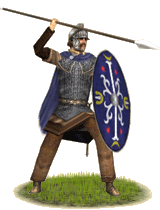 The Ischyroi Orditon, or "Mighty men of the Ordes," are the elite guard among the Getai. They trace their lineage back to the old capital at Helis, are the pinnacle of the Getic noble infantry. As the nobility of the tribe of the Ordes, they are equipped and supported by the Basileus, and unlike the tarabostes lords in their far-removed hillforts, the warrior lords of the Ordes are loyal retainers--and frequently family members--of the Getic kings. Armed with a long thrusting spear and either a sica or Keltic sword, they can be very effective in close combat with infantry and even cavalry. Protected by an iron Thraikian helm with a large iron crest, imported from Hellas, a large oval shield with a strong iron boss, a coat of mail, and occasionally greaves, they are one of the most heavily armored units in any Getic army. They are an expensive unit to train and maintain, but they are a valuable force on the battlefield, capitalizing on Getic fierceness and borrowed Hellenic and Keltic techniques to stand toe-to-toe with enemy heavy infantry.
The Ischyroi Orditon, or "Mighty men of the Ordes," are the elite guard among the Getai. They trace their lineage back to the old capital at Helis, are the pinnacle of the Getic noble infantry. As the nobility of the tribe of the Ordes, they are equipped and supported by the Basileus, and unlike the tarabostes lords in their far-removed hillforts, the warrior lords of the Ordes are loyal retainers--and frequently family members--of the Getic kings. Armed with a long thrusting spear and either a sica or Keltic sword, they can be very effective in close combat with infantry and even cavalry. Protected by an iron Thraikian helm with a large iron crest, imported from Hellas, a large oval shield with a strong iron boss, a coat of mail, and occasionally greaves, they are one of the most heavily armored units in any Getic army. They are an expensive unit to train and maintain, but they are a valuable force on the battlefield, capitalizing on Getic fierceness and borrowed Hellenic and Keltic techniques to stand toe-to-toe with enemy heavy infantry.
Historically, after the Galatai destroyed Helis, the surviving population moved north of the Istros and rebuilt their capital at Argedava, now known as Popesti. What had been an insignificant fishing and agricultural settlement quickly became one of the largest in all of the Getic lands. The population at Helis had already been well-acquainted with advanced metallurgy, and traded extensively with Skythians, Kelts, and especially Hellenes. This did not change at Argedava, which--judging from archaeological remains--became the source for the best-equipped and most disciplined Getic soldiers.
Tarabostes (Dacian Medium Cavalry)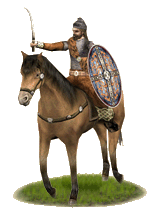 The Tarabostes are mounted war bands comprising warriors, usually veterans, attached to a war chief. They often form the main volunteer force for pillage raids. Being attached to the Getic nobility these warriors often have better equipment than their fellow Getic warriors. They are armored with chain-mail, armguards, greaves and large oval shields. They carry a spear and the sica blade. They are fearsome all-round cavalry, well armored and looking upon war as a class-affair. Their overconfidence, combined with Getic religious beliefs, makes these men prone to charge against tremendous odds as long as their chieftain is alive; thus, they lack the discipline required to any elite cavalry, but their traditional ferocity can always turn the tide of battle if properly timed or by sheer luck. The Tarabostes are mounted war bands comprising warriors, usually veterans, attached to a war chief. They often form the main volunteer force for pillage raids. Being attached to the Getic nobility these warriors often have better equipment than their fellow Getic warriors. They are armored with chain-mail, armguards, greaves and large oval shields. They carry a spear and the sica blade. They are fearsome all-round cavalry, well armored and looking upon war as a class-affair. Their overconfidence, combined with Getic religious beliefs, makes these men prone to charge against tremendous odds as long as their chieftain is alive; thus, they lack the discipline required to any elite cavalry, but their traditional ferocity can always turn the tide of battle if properly timed or by sheer luck.
Historically, the tarabostes had a much more independent spirit than any centralized authority would have preferred. Each of the more important tarabostes houses seems to have had its own dava (fortification) and each house maintained rather large forces at their own expense; their troops were experienced and loyal, bound to their leader through a system of privileges and favors. These warbands proved their worth during Burebista's campaigns against the Boii and Taursicii, where they seemed to have had the upper edge over the Celtic cavalry. Still, precisely these forces provided the tarabostes the needed self-confidence when they assassinated Burebista in 44 B.C., upon hearing the news that Caesar no longer threatened the kingdom’s borders.
Komatai Pelekuphoroi (Costobocii Axemen )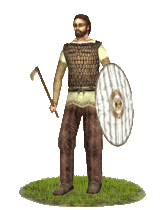 Combat traditions vary across the Getic tribes, and those on the northern and eastern sides of the Karpathoi are an excellent example. The two most powerful tribes of this region, the Karp and the Kostobok, are also among the most powerful of all the Getai. But aside from occasional wars among themselves or against their more settled neighbors to the south, these tribes are hardened by frequent war with both the nomadic Skythians, and the newly arrived Bastarnai, a migrating people ferocious in hand-to-hand combat. The battle-line warriors of the Karp and Kostobok tribes, aside from their large contingents of Drapanai, are the Pelekuphoroi, wielders of bronze axes and sturdy round shields. Even after the arrival of the iron age among their people, their warriors continued to show a preference for bronze axeheads, which, while having neither the weight nor reach of a falx, could still be devastating against armored opponents, and was more readily available among the komatai class. Their scale leather is meant at least as much to protect against Skythian arrows as against Bastarnai spears, and will do little stop a heavy, curved falx blade. These fast, hardy troops are best used in ambushes, hit-and-run attacks, or flanking maneuvers against heavier warriors, but are fierce enough to stand in the battle line if the situation demands it. Combat traditions vary across the Getic tribes, and those on the northern and eastern sides of the Karpathoi are an excellent example. The two most powerful tribes of this region, the Karp and the Kostobok, are also among the most powerful of all the Getai. But aside from occasional wars among themselves or against their more settled neighbors to the south, these tribes are hardened by frequent war with both the nomadic Skythians, and the newly arrived Bastarnai, a migrating people ferocious in hand-to-hand combat. The battle-line warriors of the Karp and Kostobok tribes, aside from their large contingents of Drapanai, are the Pelekuphoroi, wielders of bronze axes and sturdy round shields. Even after the arrival of the iron age among their people, their warriors continued to show a preference for bronze axeheads, which, while having neither the weight nor reach of a falx, could still be devastating against armored opponents, and was more readily available among the komatai class. Their scale leather is meant at least as much to protect against Skythian arrows as against Bastarnai spears, and will do little stop a heavy, curved falx blade. These fast, hardy troops are best used in ambushes, hit-and-run attacks, or flanking maneuvers against heavier warriors, but are fierce enough to stand in the battle line if the situation demands it.
Getikoi Hippotoxotai (Dacian Horse-Archers)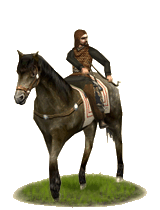 The Getai horse archers have a long and proud tradition, having developed superb skills in confrontations with the Skythai and Sauromatai. These Getai "who believe they are immortals" were the only tribes of the Thraikians whose horsemen confronted Dareios in his expedition against the Skythai in 514 BC, and for their "recklessness they were immediately subdued and forced to follow the huge Persai army, even though they are the bravest and most righteous of all Thraikes", as Herodotos notes. Their task is to kill, wound, disrupt, or simply reduce the morale of enemy infantry with endless showers of arrows, but they have problems like all horse archers in wet or damp weather. Their Skythian akinakes, a type of straight sword commonly used south of the Istros, and their fast horses enable them to make swift thrusts into the enemy flanks. However, one should never engage them in prolonged close quarters battle. The Getai horse archers have a long and proud tradition, having developed superb skills in confrontations with the Skythai and Sauromatai. These Getai "who believe they are immortals" were the only tribes of the Thraikians whose horsemen confronted Dareios in his expedition against the Skythai in 514 BC, and for their "recklessness they were immediately subdued and forced to follow the huge Persai army, even though they are the bravest and most righteous of all Thraikes", as Herodotos notes. Their task is to kill, wound, disrupt, or simply reduce the morale of enemy infantry with endless showers of arrows, but they have problems like all horse archers in wet or damp weather. Their Skythian akinakes, a type of straight sword commonly used south of the Istros, and their fast horses enable them to make swift thrusts into the enemy flanks. However, one should never engage them in prolonged close quarters battle.
Historically, the Getic horsemen won the admiration of the Hellenes when they decided to engage Dareios in Mikra Skythia; and they must have won the admiration of Dareios, as after their eventual defeat, they were pressed into service within the Persian army. Their numbers were large; Thoukydides notes, referring to the great army of supposedly 150,000 men, a third of it cavalry, recruited by the Odrysian king Sitalkes: "the largest part of the cavalry was provided by the Getai." Regarding their weapons, the composite bow transformed them into efficient killers while their horses kept them out of harm's way.
These Getai warriors are not drawn from every Getic tribe, but from the tribes living in the Danube-delta area or from the Agathyrsoi living inside the arch of the Karpathes. The Hellenes called all men living in modern-day Romania & northern Bulgaria for Getai after this tribe, while the Romans called them Dacians, which is the norm today. In earlier Greek history texts, Getai was used to describe just the one tribe, not the other tribes as well, which the term encompassed later on, when the tribes in the Carpatho-Danubian area became more organized and united.
Druhtiz Bastarnisku (Bastarnae Shock Infantry)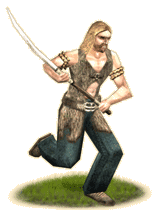 The Druhtiz Bastarnisku ("Bastarnae Warband") is a druhtiz (warband) comprised of fierce and resolute warriors, well aware of their role on the battlefield as shock troops. The falx is an intimidating weapon, especially in the hands of these experienced warriors. These men can hack a hole in almost any enemy battle line. They are the essential shock troops of any Germanic army. The Druhtiz Bastarnisku ("Bastarnae Warband") is a druhtiz (warband) comprised of fierce and resolute warriors, well aware of their role on the battlefield as shock troops. The falx is an intimidating weapon, especially in the hands of these experienced warriors. These men can hack a hole in almost any enemy battle line. They are the essential shock troops of any Germanic army.
Historically, the Bastarnoz (Bastarnae), whose name means "Ones who use bast" in their own language, originally began as a Germanic tribe and traveled far east, settling in lands near the numerous tribes of the Getai, where they mixed and adapted to the various peoples of the Black Sea steppe. Quickly, they earned fame for their capabilities in battle and were often enlisted as mercenaries. They fought for Perseus in his campaign against Rome and were involved in the battles of the Makedonians.
Illyrioi Paraktioi (Illyrian coastal levies)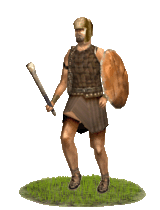 Those men when not using their boats to plunder enemy coasts or shipping, are on the lookout for easy pickings, be it from the enemies that surround them or other Illyrian tribes in their vincinity. Their helmet is a standard Illyrian helmet, simple and trustworthy. Armed with a crude mace, and a rope that they use when they assault enemy ships, to either grab them using hooks, or tie up their slaves after the fact. Rowdy and fierce against unarmed civillians, they tend to flee when armed enemies arrive. Brilliant in ambush and cunning in deceit, they can fill the ranks, but not quite hold them. Those men when not using their boats to plunder enemy coasts or shipping, are on the lookout for easy pickings, be it from the enemies that surround them or other Illyrian tribes in their vincinity. Their helmet is a standard Illyrian helmet, simple and trustworthy. Armed with a crude mace, and a rope that they use when they assault enemy ships, to either grab them using hooks, or tie up their slaves after the fact. Rowdy and fierce against unarmed civillians, they tend to flee when armed enemies arrive. Brilliant in ambush and cunning in deceit, they can fill the ranks, but not quite hold them.
Historically, Illyrians were notorious as pirates of the Adriatic. Their tribes, used small boats and ambush to offset any quality or quantity of troops stacked against them. They were very succesful. Agathokles of Sicily organised colonising expeditions in the Northern Adriatic, with stopping Illyrian piracy as a stated goal. Later it got worse. In fact Romani first expanded across the Adriatic, as an attempt to stamp off their acts of piracy.
Illyrioi Hippeis (Illyrian Light Cavalry)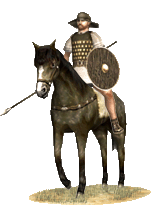 The Illyrioi field a light cavalry that has surprising tenacity on the battlefield. Armed with spears and axes, they are ideal for riding down routing infantry and attacking the flanks of vulnerable phalanxes. While not quite as useful as some cavalry, they have a definite presence as a somewhat inexpensive all-purpose melee cavalry. The Illyrioi field a light cavalry that has surprising tenacity on the battlefield. Armed with spears and axes, they are ideal for riding down routing infantry and attacking the flanks of vulnerable phalanxes. While not quite as useful as some cavalry, they have a definite presence as a somewhat inexpensive all-purpose melee cavalry.
Historically, the Illyrioi were a people that inhabited modern Albania, Bosnia, Croatia, Slovenia, Serbia and Montenegro. They were greatly influenced by their Hellenic neighbors to the south and their Makedonian neighbors to the east, but managed to stay fiercely independent until conquered by Philippos of Makedonia and Alexandros of Epeiros. That same fierceness allows them to be a reliable and fitting unit for any Epeirotes general that is clever enough to control the wild Illyrioi provinces.
Illyrioi Thureophoroi (Illyrian spearmen)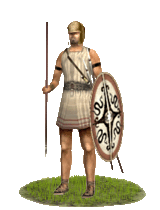 Sapping Ability\n\nLighter than the Hellenic Hoplites, that they used to fight, and equipped with a different shield, a deffinite Keltoi influence, the Illyrioi Thureophoroi, can hold the line, if needed, but their role was to harass rather than fight, and shower the enemy with spears from afar, not go up against it. At this they excell, as it is the very lack of armor which makes them very agile. Only their bronze Illyrian helmet can be considered armor as well as their thrureos shield. They carry a healty amount of javelins which they throw at the enemy but when it comes to close action with their spears, they leave a lot to be desired. Sapping Ability\n\nLighter than the Hellenic Hoplites, that they used to fight, and equipped with a different shield, a deffinite Keltoi influence, the Illyrioi Thureophoroi, can hold the line, if needed, but their role was to harass rather than fight, and shower the enemy with spears from afar, not go up against it. At this they excell, as it is the very lack of armor which makes them very agile. Only their bronze Illyrian helmet can be considered armor as well as their thrureos shield. They carry a healty amount of javelins which they throw at the enemy but when it comes to close action with their spears, they leave a lot to be desired.
Historically, Illyrioi were hammered by the same force that destroyed Makedonia and killed its king, Keraunos: the Keltoi. As one of the nations to border with them, the Boii nation of them, they did use a lot of their methods in fighting and mixing with their own peltasts, a heavier version was created, the Thureophoroi. While lighter than Hellenic Thureophoroi, they are as good as them or even better when it comes to harassing the enemy and especially pike phallanxes.
Thraikioi Doryphoroi (Thracian Light Spearmen)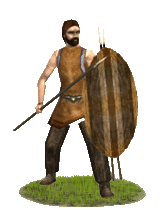 Among the Thraikian tribes, the vast majority of men of military age are too poor to fight in the bands of well-equipped units. As farmers, herders, and general pastoralists, many of these Thraikians cannot afford more than a few pieces of military equipment. For that reason many of them carry simple wooden shields, a clutch of javelins with fire-hardened wooden tips, and a simple spear. While many of the warriors who perform service for their tribe are these farmers, herders, and fishermen, many of them are also accustomed to a form of warfare through their incessant, low intensity squabbles with neighboring tribes, or even through occasional raids on passing trading parties or local trading emporia. So while they lack good weaponry, or armor, they carry a ferocious disposition - they are Thraikians, after all. While they may carry their ferocity on to the battlefield, their lack of experience in much of anything larger than a skirmish over farmland may cause their ferocity to dissipate in the face of prolonged hand-to-hand combat with well-ordered, or even professional, soldiery. They are accustomed to short skirmishes and decisive charges, and so are best used in similar roles. Among the Thraikian tribes, the vast majority of men of military age are too poor to fight in the bands of well-equipped units. As farmers, herders, and general pastoralists, many of these Thraikians cannot afford more than a few pieces of military equipment. For that reason many of them carry simple wooden shields, a clutch of javelins with fire-hardened wooden tips, and a simple spear. While many of the warriors who perform service for their tribe are these farmers, herders, and fishermen, many of them are also accustomed to a form of warfare through their incessant, low intensity squabbles with neighboring tribes, or even through occasional raids on passing trading parties or local trading emporia. So while they lack good weaponry, or armor, they carry a ferocious disposition - they are Thraikians, after all. While they may carry their ferocity on to the battlefield, their lack of experience in much of anything larger than a skirmish over farmland may cause their ferocity to dissipate in the face of prolonged hand-to-hand combat with well-ordered, or even professional, soldiery. They are accustomed to short skirmishes and decisive charges, and so are best used in similar roles.
Thraikioi Hippeis (Thracian Light Cavalry)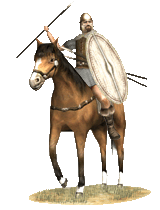 Thraikoi Hippeis are skilled Thracian skirmisher cavalry who harass their enemies with javelins. To maintain high mobility they wear no armor beneath their characteristic cloaks (called "zeira"), but their small thureos shields and Phrygian helmets with cheek guards provide some protection from their foes. They are trained in the use of the wedge formation and their Scordisci swords can be effective in close quarter fighting, but they are best used harassing infantry or slower cavalry at range. Thraikoi Hippeis are skilled Thracian skirmisher cavalry who harass their enemies with javelins. To maintain high mobility they wear no armor beneath their characteristic cloaks (called "zeira"), but their small thureos shields and Phrygian helmets with cheek guards provide some protection from their foes. They are trained in the use of the wedge formation and their Scordisci swords can be effective in close quarter fighting, but they are best used harassing infantry or slower cavalry at range.
Historically, these hard-fighting troopers were known for their fearlessness and swift maneuverability. They adopted hit-and-run cavalry tactics after their many encounters with the Skythians, making the Thraikoi Hippeis the bane of heavier and slower enemies. Megas Alexandros employed Thracian skirmisher cavalry in his journeys, and their reputation was that of hard-drinking, uninhibited people. In battle they preferred to throw the first volley of cornel-wood javelins at maximum range so they could quickly ready a follow-up volley.
Thraikioi Peltastai (Thraikian Peltasts)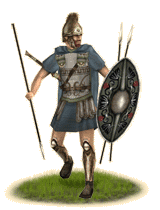 The Thraikian Peltast was the originator and the best of the peltasts and these men will often give a better service than their Hellenic counterparts. They are armored in good quality linen and carry a smaller version of the thureos style shield. They are Hellenized warriors, but still have their trademark wild beards, which serve to remind their enemies of their country of origin. They are expert javelinmen, able to pepper their targets with javelins before charging in with their fearsome rhomphaias. They are well trained and among the fiercest and most feared warriors in the entire world, and they know it. This often makes them very impetuous, but an able general should be able to keep them at bay until the right moment. Thraikioi Peltastai can be used with equal precision as skirmishers or medium shock infantry. They are even deadly against armored horsemen, due to their wicked armor-piercing blades. The Thraikian Peltast was the originator and the best of the peltasts and these men will often give a better service than their Hellenic counterparts. They are armored in good quality linen and carry a smaller version of the thureos style shield. They are Hellenized warriors, but still have their trademark wild beards, which serve to remind their enemies of their country of origin. They are expert javelinmen, able to pepper their targets with javelins before charging in with their fearsome rhomphaias. They are well trained and among the fiercest and most feared warriors in the entire world, and they know it. This often makes them very impetuous, but an able general should be able to keep them at bay until the right moment. Thraikioi Peltastai can be used with equal precision as skirmishers or medium shock infantry. They are even deadly against armored horsemen, due to their wicked armor-piercing blades.
Historically, the Thraikioi Peltastai have been around since the late Bronze Age and are often considered the archetype of the Thraikian warrior, though these Hellenized Peltastai are considerably more heavily armored than their fifth century ancestors. The Thraikioi Peltastai have been plying their deadly trade against Hellenes for as long as any Thraikian or Hellene can remember, and their method of warfare was so effective it was copied by the Hellenes and Makedonians and even mimicked by tribes as distant as the Illyrians. The number of battles and by whom they were used is uncountable. Suffice to say Thraikian peltastai have been used in every major conflict between Hellenic states, and will continue to be used.
Galathraikes (Gallo-Thracian Infantry)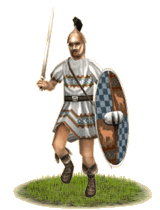 These warriors are highly sought after swordsmen from the Celtic-dominated regions of Thraikia. They carry a small, sturdy thureos, several javelins, and a Celtic longsword. They wear bronze helmets of Celtic types, which became popular after the Galatai invaded Thraikia, and wear little armament aside from this helmet and their shield, even though for the price of their arm torcs (a fusion of Thraikian and Celtic practice) they could afford some form of body armor. Many of them are veterans, former mercenaries in the armies of Hellenistic monarchs or poleis, or warriors in the tribal armies of Galatian or Thracian rulers. They carry good equipment and handle it well, and most of them have chosen to forsake armor, having learned from experience the values of mobility and endurance. They are valuable as shock troops of a sort: throwing them against unbroken ranks of sarissa spears will likely end in their deaths, but are at their best in quick assaults on flanks or against enemy fortifications.
These warriors are highly sought after swordsmen from the Celtic-dominated regions of Thraikia. They carry a small, sturdy thureos, several javelins, and a Celtic longsword. They wear bronze helmets of Celtic types, which became popular after the Galatai invaded Thraikia, and wear little armament aside from this helmet and their shield, even though for the price of their arm torcs (a fusion of Thraikian and Celtic practice) they could afford some form of body armor. Many of them are veterans, former mercenaries in the armies of Hellenistic monarchs or poleis, or warriors in the tribal armies of Galatian or Thracian rulers. They carry good equipment and handle it well, and most of them have chosen to forsake armor, having learned from experience the values of mobility and endurance. They are valuable as shock troops of a sort: throwing them against unbroken ranks of sarissa spears will likely end in their deaths, but are at their best in quick assaults on flanks or against enemy fortifications.
Historically, when the Galatai invaded Thraikia, they set up several small kingdoms: that of Tylis, and that of the Skordiskoi. Within these kingdoms, the Galatian warriors seem to have held prominence, but, especially in the case of Tylis, they were too few in number for their rulers to exclude the defeated Thraikians from the ranks of an effective army.
So members of the Odrysai and other defeated tribes integrated bit by bit into the Galatian kingdoms in Thraikia. They quickly adopted some of the Celtic weapons and armor, and began using the torc, not around the neck, but as a set, on their arms, replacing the bracelets and arm bands they had formerly used. Several Hellenistic period finds from Bulgaria have revealed warrior burials which feature a mix of Thraikian and Galatian practice: La Tene longswords, the Thracian torcs, and a number of types of eastern Celtic helmets.
Many of these soldiers likely fought for or against the kings of Tylis and of the Skordiskoi. Many others likely capitalized on the popularity of Galatians in Hellenistic armies, seeking service with the Ptolemaioi at Maroneia, or after 197, with the Seleukides in the same place. The Seleukides, if we follow Arrian, actually invaded Maroneia for the purpose of recruiting the Galatians in Thraikia. From the Hellenistic perspective, a Galatian sword and a Galatian shield usually were sufficient to constitute a Galatian, and many Thraikians and Galathraikians--the result of long cohabitation in Tylis and the lands of the Skordiskoi means it is difficult to really speak of Galatian or Thraikian as if they are fully separate from one another--likely benefited from the ambiguity surrounding Galatian identity, and from the Hellenistic monarchs' overall desire for semi-barbarian warriors, whether Thraikians or Galatians.
Taxeis Triballoi (Triballi Infantry)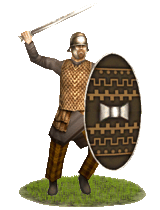 The Triballoi are a particularly fierce Thraikian tribe that contributes a very deadly assault infantry to any Thraikian warlord or any strategos who hires them. These Thraikians are wearing leather armor with ptyreges, leather greaves, Thracian helms and thureos shields and they are armed with javelins and Skythian longswords. True to their Thraikian ancestry they are ferocious warriors who fight with an intensity unmatched by other troops in the region. They are more than capable of going toe to toe with most other medium infantry and can be utterly lethal as flankers against heavier infantry. Their javelins give them another edge, as they can unleash a volley or two before closing in on the hopefully thinned enemy formation. In short, they are a very able assault infantry if properly used on the battlefield. The Triballoi are a particularly fierce Thraikian tribe that contributes a very deadly assault infantry to any Thraikian warlord or any strategos who hires them. These Thraikians are wearing leather armor with ptyreges, leather greaves, Thracian helms and thureos shields and they are armed with javelins and Skythian longswords. True to their Thraikian ancestry they are ferocious warriors who fight with an intensity unmatched by other troops in the region. They are more than capable of going toe to toe with most other medium infantry and can be utterly lethal as flankers against heavier infantry. Their javelins give them another edge, as they can unleash a volley or two before closing in on the hopefully thinned enemy formation. In short, they are a very able assault infantry if properly used on the battlefield.
Historically, the Triballoi were among the most fierce and warlike of the Thracian tribes, although that has been said about most Thracian tribes. However, it might have more merit for the Triballoi, as they were a byword for savagery and an Athenian club for lawless youths was named after them. The Triballoi were once subdued by Philippos II, and then again by Alexandros. Alexandros was so impressed by them that he hired many and brought them on his Persian expedition. They were instrumental as assault infantry, and were able to outfight the Persian infantry on every occasion that they met them. These troops had a simple philosophy of war. Throw javelins, charge, and then rip your enemies apart. For such simple tactics, they were wildly effective against most enemies.
The Triballoi were in constant contact with the Getai and Skythians and also the Illyrians. One Illyrian tribe, the Autariatai, overcame the Triballi around 424 and forced them out of their original homelands further south than their present location and they were also hard pressed centuries later when the Celts migrated to the area. The Skythian, Illyrian and later Celtic influences on the Triballoi might be the reason they are sometimes mentioned as distinct from the other Thracian tribes.
Thraikioi Rhomphaiaphoroi (Elite Thracian Infantry)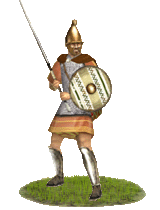 The elite infantry of the Thraikian tribes are armed with the heaviest of Thraikian weapons, the rhomphaia. Unlike most other Thraikian warriors, these warriors can afford relatively heavy armor and are thus armored with chain mail or scale cuirasses, Phrygian helmets--often with elaborately moulded cheek pieces, bronze greaves and a pelta. They are armored infantry killers of great renown, well able to chop their way through heavily armored enemy soldiers. These soldiers can even be effective against armored horsemen, since their large rhomphaia have been known to sheer through the legs of horses. In the right hands, this band of warriors can be a devastating battle-winning force in itself. The elite infantry of the Thraikian tribes are armed with the heaviest of Thraikian weapons, the rhomphaia. Unlike most other Thraikian warriors, these warriors can afford relatively heavy armor and are thus armored with chain mail or scale cuirasses, Phrygian helmets--often with elaborately moulded cheek pieces, bronze greaves and a pelta. They are armored infantry killers of great renown, well able to chop their way through heavily armored enemy soldiers. These soldiers can even be effective against armored horsemen, since their large rhomphaia have been known to sheer through the legs of horses. In the right hands, this band of warriors can be a devastating battle-winning force in itself.
Historically, there were relatively few of these soldiers in any Thraikian army, but they were always at the forefront, where the fighting was thickest. Each had risen to a position of power within his respective tribe, often they formed the elite troops of the chief or local king. The Rhomphaiaphoroi represent the pinnacle of the Thracian military know-how. In the old Thraikian way of battle, the Rhomphaiaphoroi would form the brunt of a decisive charge, once the Peltastai had worn down the enemy. Their charge was nearly unstoppable, and often led to outright routs against less stalwart opponents, as their fearful Rhomphaia, sturdy weapons composed of nearly two meters of heavy iron, could pierce thick armor, and cleave limb from torso with little trouble. With their row of long iron points, bands of Rhomphaiaphoroi could also defend against oncoming horse, and when wielded by a skilled swordsman a single blow could hamstring a horse or sever an enemy’s limbs.
Misthophoroi Thraikioi Prodromoi (Thracian Medium Cavalry)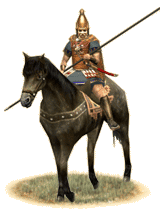 In the Thraikian and Makedonian armies, these medium cavalry are a common sight. The reason for this is that they are excellent medium cavalry, capable of skirmishing, charging, and fighting fairly well in melee. They are armored with good quality linen, bronze helms, and the distinctive Thraikian shields that mark their country of origin. They are an extremely versatile cavalry force that can be given the moniker ‘jack of all trades and master of none’. They are great all-round cavalry, but will not fare well against heavier cavalry or spear or pike armed infantry. They are drawn from the lower Thraikian nobility and many have settled in Makedonia, lured by land grants and higher pay. In the Thraikian and Makedonian armies, these medium cavalry are a common sight. The reason for this is that they are excellent medium cavalry, capable of skirmishing, charging, and fighting fairly well in melee. They are armored with good quality linen, bronze helms, and the distinctive Thraikian shields that mark their country of origin. They are an extremely versatile cavalry force that can be given the moniker ‘jack of all trades and master of none’. They are great all-round cavalry, but will not fare well against heavier cavalry or spear or pike armed infantry. They are drawn from the lower Thraikian nobility and many have settled in Makedonia, lured by land grants and higher pay.
Historically, Thraikian light cavalry was some of the best in the ancient world. They proved their worth in battle after battle, whether in Makedonian or Hellenic service, or the service of their own kings. Their tactical versatility made them a light cavalry equivalent to that of the Romaioi legions, well able to perform any battle role and to adapt quickly to any circumstance.
Akontistai (Hellenic Skirmishers)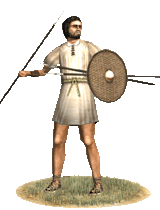 Those unlucky enough to be extremely poor freedmen were pressed into service as psiloi, missile units, and the lowest class of Hellenic infantry. The Psiloi were divided into three parts: javelineers, slingers, and archers. The javelin-armed Psiloi, the Akonistai, were ragged peasants armed with javelins and small knives. Their function was simply to throw their missiles and then run as fast as possible to safety behind the Hoplitai lines. They were used for skirmishing and to provide a demoralizing hail of missile fire during the grinding battle between the two phalanxes. Never use Akonistai in melee except as diversionary fodder or as a flanking force; roles in which they don’t excel, but might actually be better than nothing. They have their uses, as their javelins are still sharp and deadly, but they were often used only as light skirmishers or as a last resort in Hellenic armies for obvious reasons. Those unlucky enough to be extremely poor freedmen were pressed into service as psiloi, missile units, and the lowest class of Hellenic infantry. The Psiloi were divided into three parts: javelineers, slingers, and archers. The javelin-armed Psiloi, the Akonistai, were ragged peasants armed with javelins and small knives. Their function was simply to throw their missiles and then run as fast as possible to safety behind the Hoplitai lines. They were used for skirmishing and to provide a demoralizing hail of missile fire during the grinding battle between the two phalanxes. Never use Akonistai in melee except as diversionary fodder or as a flanking force; roles in which they don’t excel, but might actually be better than nothing. They have their uses, as their javelins are still sharp and deadly, but they were often used only as light skirmishers or as a last resort in Hellenic armies for obvious reasons.
Historically, Akontistai did not play a particularly large role on the battlefield, and weren’t normally a particularly decisive force. They were used mainly for their ability to induce an enemy to attack prematurely. They are little more than an annoyance on the open field, but can be deadly if positioned in places where their javelins can be used for maximum effect: on high terrain, on an enemy unit’s flank, or atop a city wall.
Sphendonetai (Hellenic Slingers)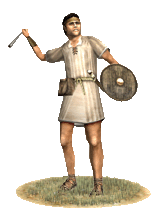 Sphendonetai are the second branch of the Psiloi, and are only marginally more useful than their compatriots with javelins. Their sphendonai (slings) can prove deadly weapons, being able to crush bones and armor, and shatter shields from a distance, but they are mainly used to harass and annoy enemy soldiers to force a premature or rash action. Since a sphendone is an easily constructed weapon, and ammunition is readily available in Hellas’ rocky terrain, Sphendonetai are mostly poor peasants and shepherds that use this weapon to provide a meagre amount of protein in their already poor diet or use their weapons to keep predators away from their flocks. Sphendonetai are the second branch of the Psiloi, and are only marginally more useful than their compatriots with javelins. Their sphendonai (slings) can prove deadly weapons, being able to crush bones and armor, and shatter shields from a distance, but they are mainly used to harass and annoy enemy soldiers to force a premature or rash action. Since a sphendone is an easily constructed weapon, and ammunition is readily available in Hellas’ rocky terrain, Sphendonetai are mostly poor peasants and shepherds that use this weapon to provide a meagre amount of protein in their already poor diet or use their weapons to keep predators away from their flocks.
Historically, sphendonetai had their uses, they were often used to harass and provoke the enemy forces by causing some casualties and some damage to the enemy’s armament, particularly the shields, which were easily dented or cracked by a well slung glande (sling projectile). Alexandros employed his Sphendonetai at the battle of Gaugamela to harass the Persian heavy cavalry until they decided to give fight, and then promptly cut them off from the rest of the Persian army, allowing the Hetairoi to cut them to shreds.
Toxotai (Hellenic Archers)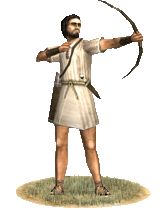 Toxotai are the third branch of the Psiloi, the archers of Hellenic and Makedonian armies. They are generally from the upper end of the poor and recruited from mountainous regions where the use of the bow is an essential skill to keep one’s flock of sheep safe from roving predators. Toxotai are well trained in a manner of speaking, that being that they are using their weapon of choice (often of necessity) from birth. They are decent archers, but are nowhere near as professional as the archers from the east and south. They mostly use the short bow, which means that they are often outranged by their counterparts from other lands. This reflects their secondary role in a Hellenic army. As most missile units, they will be cut to ribbons in melee, so they should be well protected from enemy ranks. Toxotai are the third branch of the Psiloi, the archers of Hellenic and Makedonian armies. They are generally from the upper end of the poor and recruited from mountainous regions where the use of the bow is an essential skill to keep one’s flock of sheep safe from roving predators. Toxotai are well trained in a manner of speaking, that being that they are using their weapon of choice (often of necessity) from birth. They are decent archers, but are nowhere near as professional as the archers from the east and south. They mostly use the short bow, which means that they are often outranged by their counterparts from other lands. This reflects their secondary role in a Hellenic army. As most missile units, they will be cut to ribbons in melee, so they should be well protected from enemy ranks.
Historically, the Hellenes did not use archers in any significant fashion. They did not have the composite bows of their neighbours, and their lands were not particularly suited to the cattle and horse farming that supplied the raw material for these bows. Therefore, archers fulfilled the same role as other Psiloi: that of long range harassment. The Hellenes and Makedones had no real tradition of archers and could not recruit any but these shepherds to do this work for them, since they lacked any access to the archers of the east. Most Hellenic states relied on Skythian and most importantly Kretan archers to do this for them.
Hoplitai (Greek Classical Hoplites)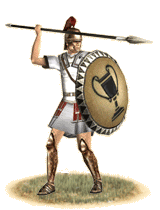 Even though the Makedonian Phalangitai have become the dominant infantry type among the Hellenic powers, the Hoplitai of old who fight in much the same manner as the Hellenes did at Thermopylai, Marathon and Plataiai, are still around defending their poleis. Each hoplites is equipped with linen or leather armor, an aspis shield, greaves, the attic style helmet and of course, his spear. The equipment might have changed since the battles of centuries past, but their tactics have not. The Hoplitai still fight in the phalanx formation, often eight man deep whose purpose is to advance forward upon the enemy line, tie them and to whittle them down through attrition. Even though the Makedonian Phalangitai have become the dominant infantry type among the Hellenic powers, the Hoplitai of old who fight in much the same manner as the Hellenes did at Thermopylai, Marathon and Plataiai, are still around defending their poleis. Each hoplites is equipped with linen or leather armor, an aspis shield, greaves, the attic style helmet and of course, his spear. The equipment might have changed since the battles of centuries past, but their tactics have not. The Hoplitai still fight in the phalanx formation, often eight man deep whose purpose is to advance forward upon the enemy line, tie them and to whittle them down through attrition.
Historically, the hoplites is one of the most famous types of soldiers that has ever existed. The Hellenic military ethos and culture from the 8th century until the Roman hegemony created a highly skilled heavy infantryman. This combined with the phalanx formation, proved to be key factors in winning over the numerically larger Persian and barbarian armies of the day.
The Hoplitai were mostly drawn from the well-to-do citizens of a polis, who often had a stake in the outcome of the battle or war to come, and who were bound to eachother by a patriotic feeling to their home city, creating a body of citizen-warriors whose motivation was unlike that of any levy, mercenary or other professional soldiers. The hoplites of the Hellenic city states continued to be the dominant infantry type on the battlefield for almost two centuries after the Persian Wars, but the appearance of the Peltastai made them more vulnerable than before and highlighted the shortcomings of the phalanx. Then the rise of Makedonia in the north and its Phalangitai, caused the decline of the "classical" hoplites being fielded in large numbers. However, variants of the hoplites were succesfully adapted by various Hellenic powers, such as the Ekdromoi and Thorakitai Hoplitai. And even after the wars of Alexandros and those of his successors, some poleis and smaller communities still fielded contingents of Hoplitai, who were trained and fought in the same fashion as the Hoplitai of old.
Misthophoroi Hippeis (Mercenary Greek Medium Cavalry)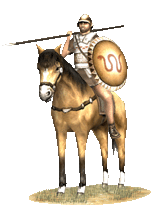 Greek cavalry is not the most awe inspiring and powerful in the world, but they are no slouches either. Hippeis are a mix of good old fashioned Greek know-how with the practical needs for an effective medium cavalry force. The result is the wedding of linen armor, attic helmets, and hoplon shields to cavalry spears and the xiphos, which produces a warrior with excellent all-round equipment. Since they are mainly drawn from elite nobility, these cavalrymen have a high morale and a good discipline. They ride stout horses whose stock was imported from the north. They are an able, if not spectacular, medium cavalry. Greek cavalry is not the most awe inspiring and powerful in the world, but they are no slouches either. Hippeis are a mix of good old fashioned Greek know-how with the practical needs for an effective medium cavalry force. The result is the wedding of linen armor, attic helmets, and hoplon shields to cavalry spears and the xiphos, which produces a warrior with excellent all-round equipment. Since they are mainly drawn from elite nobility, these cavalrymen have a high morale and a good discipline. They ride stout horses whose stock was imported from the north. They are an able, if not spectacular, medium cavalry.
Historically, Greek cavalry was always thought of as better than Roman cavalry, even though it was not particularly significant. The Greeks have enough trouble keeping the equestrian minded Macedonians to the north at bay without having to worry about doing much of significant note.
Sphendonetai Rhodioi (Rhodian Slingers)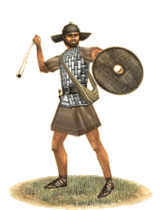 These men hail from Rhodos, one of the most storied states and greatest mercantile powers in the Hellenistic world, famous for its fine slingers throughout the Classical and Hellenistic periods. Men like these traveled with Xenophon, fought in the armies of Phillip and Alexander, and served as mercenaries with most of the major powers even through Roman domination. They are armed with slings made from leather, as well as hemp and flaxen cord, and are armored in a padded linen 'half-cuirass'. This gives them some longevity in melee combat, but they are best withdrawn before melee begins in earnest. Their missiles will rain death upon most foes, and they out-range most enemies.
These men hail from Rhodos, one of the most storied states and greatest mercantile powers in the Hellenistic world, famous for its fine slingers throughout the Classical and Hellenistic periods. Men like these traveled with Xenophon, fought in the armies of Phillip and Alexander, and served as mercenaries with most of the major powers even through Roman domination. They are armed with slings made from leather, as well as hemp and flaxen cord, and are armored in a padded linen 'half-cuirass'. This gives them some longevity in melee combat, but they are best withdrawn before melee begins in earnest. Their missiles will rain death upon most foes, and they out-range most enemies.
Historically, slingers from Rhodes and others trained in their methods made significant contributions to Hellenic and Successor armies. Xenophon's Anabasis is probably the clearest example, where slingers from Rhodos are able to outfight archers and presumably keep mounted archers at bay. They performed the latter function for Alexander as well, in concert with bolt-throwing engines. In the acceding Hellenistic age, their use by virtually every power is a testament to their effectiveness. Slingers from Rhodos appear later in the Roman army, but history from later periods becomes increasingly sketchy.
Misthophoroi Toxotai Kretikoi (Mercenary Cretan Archers)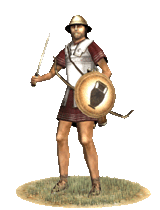 The island of Crete is renown for it's archers, and Cretans renown for their reputation as liars and brigands. These men hire themselves out as mercenaries for almost any Mediterranean power who can afford them, as their skills are often unmatched by other archers. Apart from their bow, they also have short swords and they wear hardened linen armor and carry a small shield. Not only are the Cretans good archers, but they can also fare well in melee, although against similarily equipped opponents. The island of Crete is renown for it's archers, and Cretans renown for their reputation as liars and brigands. These men hire themselves out as mercenaries for almost any Mediterranean power who can afford them, as their skills are often unmatched by other archers. Apart from their bow, they also have short swords and they wear hardened linen armor and carry a small shield. Not only are the Cretans good archers, but they can also fare well in melee, although against similarily equipped opponents.
Historically, Toxotai Kretikoi served in most Hellenic armies and other Mediterranean armies from early history, from Carthage in the west to the Seleukids in the east. One of their most famous exploits was in Xenophon's "Ten Thousand", where they gave a good account of themselves against the Persians. Crete during this time was rife with civil wars, and it was often those Cretans on the losing side or who get fed up with the unstable situation, who migrated overseas and hired themselves out as mercenary bowmen. The Diadochoi tried to gain control of the island, but were unsuccesful in their attempts. The constant civil wars attracted outlaws and other unwantables to Crete, that during the Hellenistic period bad behaviour was called "Cretan Way" and during the 1st century BC, the Cilician pirates established themselves on Crete and many Cretans joined them in piracy, which drew the ire of Rome. The first Roman expedition in 74 BC was soundly defeated, but the second expedition in 68 BC managed with great brutality to subjugate the island, which was afterwards made into a military colony, who for centuries to come supplied the Roman army with auxiliary archers, and their renown continued well into the Middle Ages. There is even distinct mention of Cretan archers defending Constantinople in 1453 AD!!
Hippeis Thessalikoi (Thessalian Heavy Cavalry)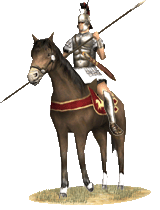 Thessalikoi heavy cavalry are drawn from the nobility of Thessalia, a region thoroughly under Makedonian control. They are extremely valuable heavy cavalry, well able to crush enemy resistance with a single thunderous charge. While not quite as powerful as the Hetairoi of Makedonia itself, the Thessalikoi are well able to give a good account of themselves in battle. Their lances and blades, combined with their shields, make them well able to hold in a melee after the charge has been completed and they have a degree of discipline that is enviable among cavalry warriors. Thessalikoi heavy cavalry are drawn from the nobility of Thessalia, a region thoroughly under Makedonian control. They are extremely valuable heavy cavalry, well able to crush enemy resistance with a single thunderous charge. While not quite as powerful as the Hetairoi of Makedonia itself, the Thessalikoi are well able to give a good account of themselves in battle. Their lances and blades, combined with their shields, make them well able to hold in a melee after the charge has been completed and they have a degree of discipline that is enviable among cavalry warriors.
Historically, Thessalia was famous for its heavy cavalry. Unlike southern Hellene regions, the Thessalikoi had a wide expanse of plains and were able to breed horses extensively. They were able to keep the other Hellenes at bay even though they were poorer and less populous than their southern neighbors. They were joined with Makedonia during the reign of Phillipos, and provided cavalry to fuel Alexandros’ conquests. After Alexandros, they continued to provide heavy cavalry to the Makedonians until the Rhomaios invasion of 146 BC that destroyed much of Thessalia’s infrastructure. There is evidence that by this time heavy cavalry was employed only in smaller numbers, due to cost.
|
 |
|
 |






















|